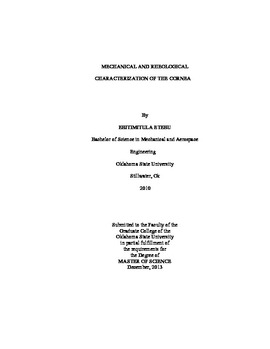| dc.contributor.advisor | Hatami-Marbini, Hamed | |
| dc.contributor.author | Etebu, Ebitimitula | |
| dc.date.accessioned | 2016-04-15T21:49:21Z | |
| dc.date.available | 2016-04-15T21:49:21Z | |
| dc.date.issued | 2013-12-01 | |
| dc.identifier.uri | https://hdl.handle.net/11244/33413 | |
| dc.description.abstract | The cornea is a semi-permeable connective tissue with multiple simultaneous functions that include load bearing, hydration regulation via fluid transport, maintaining eye ball shape, and transmitting incident light without scattering. Cornea is the transparent outer coat of the eyeball that provides 70% of the eyes refractive power. It is also a load bearing material that protects the inner ocular contents from accidental impacts. From a mechanical standpoint, the cornea is a semipermeable hydrophilic gel with a fibrillar components and negatively charged proteoglycans. The cornea's capability to transmit light is dependent on its ability to maintain its unique structure, which gives rise to its mechanical properties. In this thesis, mechanical properties of the corneal stroma were characterized. Unconfined compression was used to characterize compressive properties of the porcine corneal stroma. Using this technique, this research study characterized the effects of environmental parameters, e.g temperature, sample thickness and diameter. Furthermore, a rheometer was used to conduct the torsional shear experiments and measure shear properties of the tissue. It was observed that the cornea displayed time dependent behavior. The theoretical biphasic model was used to numerically represent the transient compressive behavior observed in experimental measurements and predict the material parameters of the cornea. The in-plane Young's modulus, out-of plane Young's modulus, and permeability of the porcine cornea were estimated as a function of tissue thickness and loading rate. In the end, a finite element biphasic model of the corneal behavior in construction was constructed. The results of the finite element analysis was mesh size dependent but converged to the theoretic and experimental measurements using very fine mesh. In summary, this thesis characterized compressive and torsional mechanics of the porcine cornea at varying compressive strains. It is expected that the findings of the present work would enhance the accuracy of corneal constitutive models, these numerical models are necessary for calibrating applanation tonometry devices which are commonly used in clinical measurements. In addition, the reported data in this thesis can be used to compare the mechanical properties of engineered corneal equivalents with those of the native tissue. | |
| dc.format | application/pdf | |
| dc.language | en_US | |
| dc.publisher | Oklahoma State University | |
| dc.rights | Copyright is held by the author who has granted the Oklahoma State University Library the non-exclusive right to share this material in its institutional repository. Contact Digital Library Services at lib-dls@okstate.edu or 405-744-9161 for the permission policy on the use, reproduction or distribution of this material. | |
| dc.title | Mechanical and Rheological Characterization of the Cornea | |
| dc.type | text | |
| dc.contributor.committeeMember | Good, James | |
| dc.contributor.committeeMember | Yin, Wei | |
| osu.filename | Etebu_okstate_0664M_13032.pdf | |
| osu.accesstype | Open Access | |
| dc.description.department | Mechanical & Aerospace Engineering | |
| dc.type.genre | Thesis | |
